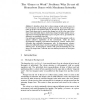Free Online Productivity Tools
i2Speak
i2Symbol
i2OCR
iTex2Img
iWeb2Print
iWeb2Shot
i2Type
iPdf2Split
iPdf2Merge
i2Bopomofo
i2Arabic
i2Style
i2Image
i2PDF
iLatex2Rtf
Sci2ools
CEEMAS
2005
Springer
2005
Springer
The "Dance or Work" Problem: Why Do not all Honeybees Dance with Maximum Intensity
A honeybee colony has to choose among several nectar sources in the environment, each fluctuating in quality over time. Successful forager bees return to the hive and perform dances to describe the food sources they have found. Each dancer tries to recruit other forager bees to fly to the source it has found. Some individual dancers clearly dance longer for higher quality sources, other dancers distinguish little between poor and good sources; presumably the differences are genetically based [6]. Our multi-agent simulation showed that this individual heterogeneity results in optimal collective exploitation of the environment. Under all tested environmental conditions near-natural heterogeneous colonies worked more efficiently than artificially homogeneous ones. In heterogeneous colonies, dances last sufficiently long to recruit an appropriate number of waiting dancefollowing bees. In homogeneous colonies with good discriminating bees, the dances last longer than is efficient; the extra...
| Added | 26 Jun 2010 |
| Updated | 26 Jun 2010 |
| Type | Conference |
| Year | 2005 |
| Where | CEEMAS |
| Authors | Ronald Thenius, Thomas Schmickl, Karl Crailsheim |
Comments (0)

